Taichung International Airport
Taichung International Airport (Chinese: 臺中國際機場) (IATA: RMQ, ICAO: RCMQ), previously known as Ching Chuan Kang Airport (清泉崗機場), is an international airport located in Taichung, Taiwan, which is used for both commercial and military purposes.The military part is called Ching Chuan Kang Air Base, the largest air base in Taiwan. It is also the third international airport in Taiwan, with scheduled services to China, Hong Kong, Japan, Macao, South Korea, Thailand and Vietnam.
Taichung International Airport 臺中國際機場 | |||||||||||
|---|---|---|---|---|---|---|---|---|---|---|---|
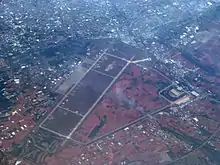 | |||||||||||
| Summary | |||||||||||
| Airport type | Military/Civil | ||||||||||
| Operator | Civil Aeronautics Administration Ministry of National Defense | ||||||||||
| Serves | Greater Taichung | ||||||||||
| Location | Taichung City, Taiwan | ||||||||||
| Elevation AMSL | 663 ft / 203 m | ||||||||||
| Coordinates | 24°15′53″N 120°37′14″E | ||||||||||
| Map | |||||||||||
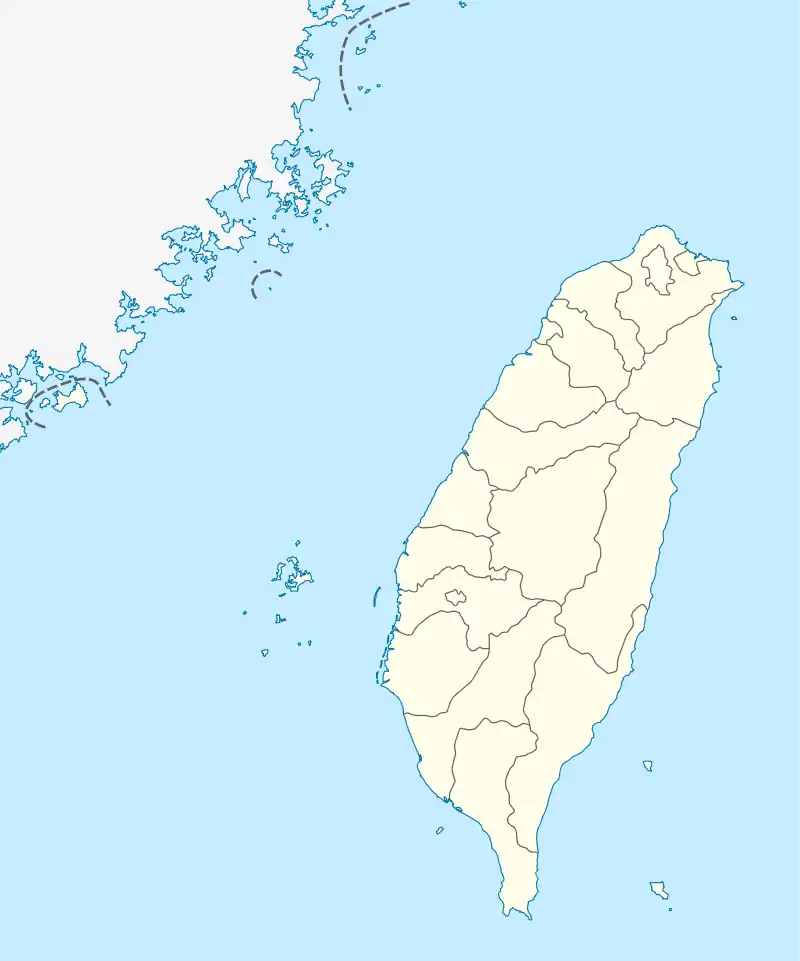 RMQ Location of airport in Taiwan | |||||||||||
| Runways | |||||||||||
| |||||||||||
| Statistics (2018) | |||||||||||
| |||||||||||
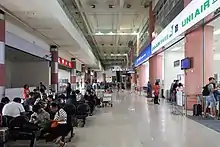
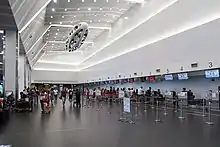
_at_Taichung_Airport.jpg.webp)
History
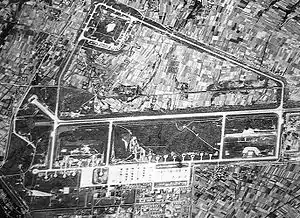
Taichung International Airport was constructed during the era of Japanese rule and was named Kōkan Airport (Japanese: 公館空港). The United States Air Force (USAF) had been garrisoning the base with two fighter squadrons until the Sino-American Mutual Defense Treaty came into force on March 3, 1955. The airport then expanded in 1954 according to the Sino-American Mutual Defense Treaty, and later renamed Ching Chuan Kang Air Base (CCK) in memory of General Qiu Qingquan. In 1966 the American Air Force established a joint forces air-base at CCK. It was the largest air force base in the Far East at the time, allowing Boeing B-52 Stratofortress bombers to land. During the Vietnam War, CCK became a depot for the USAF. The US Military used CCK and Shuinan Airport to run many of its long-distance Vietnam, Cambodia and Laotian bombing, scouting and cargo transport runs during the Vietnam War era. This base was shut down and most American facilities were removed after U.S. established diplomatic relations with China in 1979.[1]
Construction of passenger facilities was completed in September 2003 and civilian services began on March 5, 2004, replacing the old Shuinan Airport located closer to downtown Taichung. Ching Chuan Kang Airport has since become the only airport serving Taichung. The airport was promoted to an international airport on January 3, 2017, and renamed Taichung International Airport (臺中國際機場).[2]
In 2003, with the demand to develop cross-strait and other international air routes from Taichung City, Taiwanese officials made the decision to transfer airports from Shuinan Airport (TXG) to RMQ; since RMQ had been for the airbase for ROCAF, the Taiwanese CAA held negotiations with the air force, which led to the air force allowing an edge for building a new civilian terminal. The first terminal was completed in 2004, and all flights moved from TXG to RMQ soon afterwards. In 2008, officials decided to build another terminal. Terminal 2 now handles all international/cross-strait flights, while the older Terminal 1 serves domestic flights.
Airlines and destinations
Statistics
| Rank | Airport | Category | Passengers | % Change 2018 / 17 | Carriers |
|---|---|---|---|---|---|
| 1 | International | 720,648 | Mandarin Airlines, Cathay Dragon, HK Express | ||
| 2 | Domestic | 516,630 | Uni Air, Far Eastern Air Transport | ||
| 3 | Domestic | 435,211 | Uni Air, Far Eastern Air Transport | ||
| 4 | International | 225,329 | Mandarin Airlines, VietJet Air | ||
| 5 | International | 209,976 | EVA Air, Tigerair Taiwan | ||
See also
| Wikimedia Commons has media related to Taichung Airport. |
References
- Taichung Airport
- "清泉崗機場正名 台中國際機場揭牌-風傳媒" (in Chinese). Retrieved 2017-01-30.
- http://m.focustaiwan.tw/news/asoc/201911200022.aspx
- Liu, Jim. "T'Way Air expands Taichung service in Sep/Oct 2019". Routesonline. Retrieved 21 August 2019.
- "國際及兩岸定期航線班機載客率-按航線分" (PDF). CAA. CAA. Retrieved 28 January 2019.
- "國內航線班機載客率-按航空公司及航線分" (PDF). CAA (in Chinese). Retrieved 28 January 2019.
External links
- Taichung International Airport Official Website
- Airport information for RCMQ at World Aero Data. Data current as of October 2006.